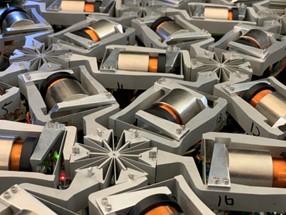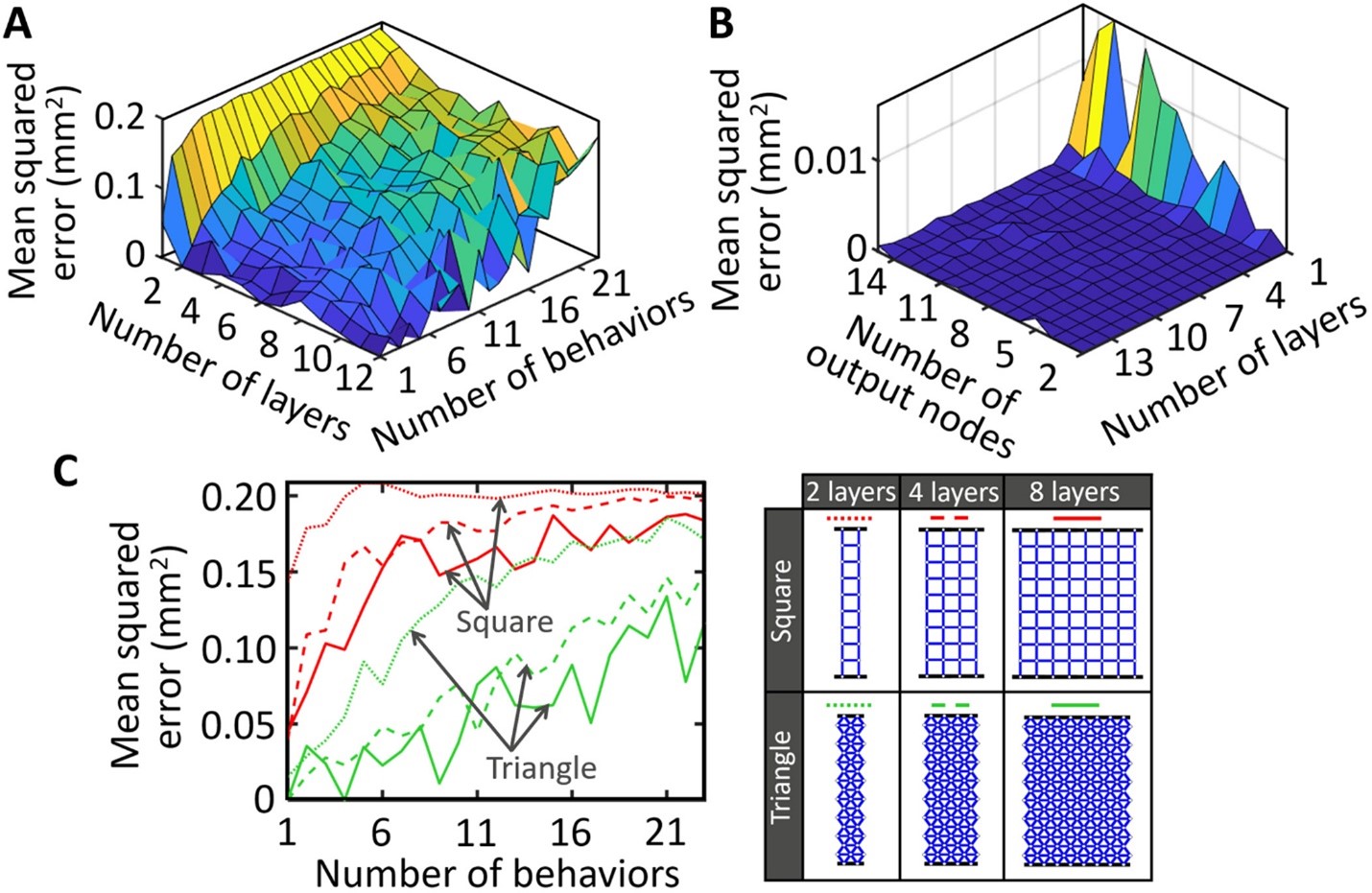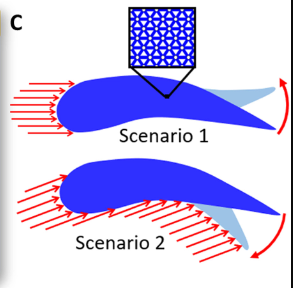Mechanical Neural Networks
By CJ Tebben
Note: This article may be incomplete and not include relevant information found after the time of creation. Mechanical neural networks are a rapidly developing field with new discoveries being made monthly.
Mechanical neural networks are a type of architected material based on the principles of artificial neural networks ([1]) in that it can react and reshape itself depending on the forces it receives from the outside world. The only current design structure that has been physically created and tested is the mechanical lattice ([2]) developed by researchers from the University of California ([3]) and the University of Twente ([[4]]) (Sparkes). In theory, the function and properties of a mechanical neural network is based on the structure and geometry as opposed to the material used, in contrast to the properties of most other mechanical designs (Sterjovski). Manufacturing of the mechanical lattice has currently only occurred at the 2D level, but research is underway into applying the complex design of mechanical neural networks to smaller systems.
Contents
Model
Like an artificial neural network, mechanical neural networks are based upon the ability of a system to calculate an output from input layers and then change the system itself through learning. While artificial neural networks send neural spikes at outputs and change synaptic weights to learn, mechanical neural networks respond to inputs (external forces acting upon the system) by altering the physical properties of the materials involved. In the case of the mechanical lattice prototype, electromechanical springs with variable stiffness were used to form the triangular lattice (Kamath). For each input, a computer algorithm was used to shift the connections between the different springs so that the desired shape was formed. This is equivalent to the learning algorithm of an artificial neural network, altering the ‘weights’ or connections between the springs to produce the desired output. One prototype 2D triangular lattice was created and tested with various inputs and desired shapes, but other possible configurations were simulated by the researchers. As with artificial neural networks, simulating more layers of the mechanical neural network correlated with reduced mean square error ([5]). However, physically creating more layers and 3D versions of the triangular lattice setup will require more advancements in microengineering ([6]). Smaller individual pieces of the network with precise flexibility and tension will have to be created, and this type of multilayer MNN is still only theoretical.
Figure 1: Analogous comparison between artificial and mechanical neural networks
Figure 2: 2D prototype of mechanical lattice model from the University of California and the University of Trente
History
In the early 2000s, artificial neural networks started being used to model the properties of materials like steel (Kadi, Sterjovski). In a 2005 paper, Sterjovski and associates were able to use backpropagation ([7]) to predict both the properties and outputs of various steels at different states. This principle of using artificial neural networks to model mechanical properties eventually translated to an application of ANN principles to mechanics itself. In the revolutionary paper published in October 2022 by researchers from UC and Lente, they lay out how they programmed materials themselves with neural network algorithms. Both the construction of the individual beams and their arrangement needed to be tested and refined. Originally, the mechanical neural network was predominantly made from PTFE ([8]), but this proved untenable as the beams would deform during prolonged periods of change in the springs. Multiple arrangements of beams were also tested before the triangular lattice model was found to be optimal, including a square lattice. Principles of force scaling were not tested in the initial paper, as the team was unable to construct MNNs of different sizes with their resources at the time (Lee). The only functional network constructed contained 21 beams, each 15 centimeters long. A computer trains the motors and springs within each beam to set their stiffness (the ‘weights’ of the neural networks) and then after this learning, the stiffness of each beam is locked until future learning. However, the team did conduct computer stimulated models of MNNs of varying sizes and dimensionalities to test their algorithmic principles (Figure 4). Mechanical neural networks have yet to be employed in any real-world context, but as the scientific community reviews and refines the initial principles developed by the researchers at UC and Lente, practical and useful applications are sure to be found.
Figure 3: Simulated experiments measuring MSE in different mechanical neural networks. A) MNNs with different numbers of layers and behaviors, B) MNNs with different numbers of layers and output nodes, C) MNNs with different configurations (triangular and square), D) MNNs with different configurations learning different numbers of behaviors
Applications
In interviews, the main application stressed by head researcher Ryan Lee was the possibility of morphable airplane wings (Lee, The Conversation) (Figure 2). If airplane wings are constructed from a mechanical neural network that is correctly trained to respond to varying wind forces, the wing can change shapes under different wind conditions without any electronic or human input. The programmed stiffnesses of beams in an MNN for airplane wings could be saved and 3D printed without any need for further learning and could become efficiently industrialized. This application would require extensive miniaturization of the current functional MNN model. Other possible applications could include the construction of whole buildings that respond to wind and seismic conditions appropriately. Current wind adaptation models in buildings require hydraulic weights constantly shifting, but mechanical neural networks could create a whole building that shifts its stiffness and flexibility to withstand high winds and seismic shifts. Other applications will surely be found over time, but the concept of MNNs is still young and unoptimized.
Figure 4: Model of potential shape-morphing behaviors in a mechanical neural network wing
Bibliography
Kadi, H. E. (2006, May). Modeling the mechanical behavior of fiber-reinforced polymeric composite materials using artificial neural networks-A Review. Composite Structures. Retrieved November 6, 2022, from https://www.sciencedirect.com/science/article/pii/S0263822305000243
Kamath, B. (2022, October 27). Finally, mechanical devices have neural networks. Analytics India Magazine. Retrieved November 6, 2022, from https://analyticsindiamag.com/finally-mechanical-devices-have-neural-networks/
Lee, R. H. (2022, October 20). A new type of material called a mechanical neural network can learn and change its physical properties to create adaptable, strong structures. The Conversation. Retrieved November 6, 2022, from https://theconversation.com/a-new-type-of-material-called-a-mechanical-neural-network-can-learn-and-change-its-physical-properties-to-create-adaptable-strong-structures-192800
Lee , R. H., Mulder, E., & Hopkins, J. (2022, October 19). Mechanical neural networks: Architected materials that learn behaviors ... ScienceRobotics. Retrieved November 6, 2022, from https://www.science.org/doi/10.1126/scirobotics.abq7278
Sparkes, M. (2022, October 26). Mechanical neural network could enable Smart Aircraft Wings that Morph. New Scientist. Retrieved November 6, 2022, from https://www.newscientist.com/article/2342654-mechanical-neural-network-could-enable-smart-aircraft-wings-that-morph/
Sterjovski, Z., Nolan, D., Carpenter, K. R., Dunne, D. P., & Norrish, J. (2005, December 30). Artificial Neural Networks for modelling the mechanical properties of steels in various applications. Journal of Materials Processing Technology. Retrieved November 6, 2022, from https://www.sciencedirect.com/science/article/pii/S0924013605006400



